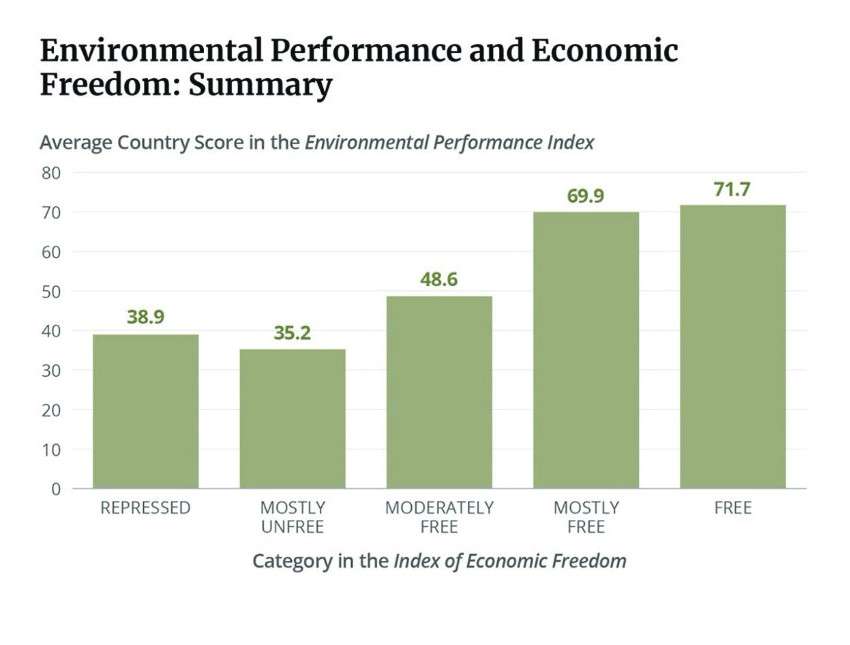Free Markets Are the Best and Fastest Way to Cut Greenhouse Gas Emissions
Top-down mandates will only slow down the energy transition.

Glasgow—The Freedom and Climate Symposium was convened on November 8 at Strathclyde University by the think tank the Conservative Coalition for Climate Solutions (C3 Solutions) as a concurrent event with the United Nations Framework Convention on Climate Change's 26th Conference of the Parties (COP26). The symposium brought together energy entrepreneurs, finance experts, free market climate policy wonks, and young conservative climate activists to discuss the role of free markets in addressing the problem of man-made climate change and managing the energy transition from fossil fuels. The solutions discussed at this meeting stood in stark contrast to the government-mandated, top-down policies being promoted by most participants at COP26.
For example, the symposium featured such proposals as the Clean Capitalism Leadership Council's Rod Richardson's clean tax cuts as a technology-agnostic way to speed up the financing of technologies that cut emissions of greenhouse gases such as carbon dioxide released by burning fossil fuels. Meanwhile, venture capitalist and insurgent ExxonMobil board member Andy Karsner promoted the Climate Leadership Council's carbon fee and dividend plan, which would put a price on carbon dioxide emissions and rebate all of the revenues collected as annual dividends amounting to about $2,000 for a family of four.
Richardson argued that his proposal would lift constraints from entrepreneurs and investors whereas the carbon fee would impose burdens on consumers and businesses. Karsner countered that stable price signals were important to encourage investment and uptake of emissions reduction technologies. Some participants wondered if clean tax cuts would really incentivize clean energy investments, since at current interest rates the price of capital is already pretty low. Others worried about public reaction when carbon emissions started to fall and dividend checks began to dwindle.
Markets are already playing a clear role in cleaning up the environment. And, generally speaking, the more free market a country is, the cleaner its environment is. A freer market also means that a country's carbon emissions are already falling. C3 Solutions' Director of Public Policy Nick Loris made this clear in his report, "Free Economies are Clean Economies."
Loris used data from the Heritage Foundation's Index of Economic Freedom that ranks 180 countries on a 100-point scale evaluating measures such as how well they protect property rights, government size, regulatory efficiency, and openness of their markets. Based on these calculations, the Index labels countries as repressed, mostly unfree, moderately free, mostly free, and free. Loris then compared these economic freedom rankings with Yale University's Environmental Performance Index, which ranks 180 countries on a 100-point scale, judging their performance with respect to air and water pollution, biodiversity, agriculture, and climate change.

Loris found that the correlation between economic freedom and cleaner natural environments is robust.
The U.S. is 20th in the freedom rankings and is ranked 24th on the environmental performance index. China, by contrast, stands at 107th in the freedom index and 120th on the environmental performance scale.
Loris argued that the correlation between freedom and environmental quality confirms the notion of the environmental Kuznets curve (EKC), a concept that says that the natural environment initially deteriorates as industrial development takes off but begins to improve as incomes increase and now wealthier people demand cleaner water, clearer air, and environmental amenities like parks. Although there is still considerable debate over whether an EKC for carbon dioxide emissions exists, Loris cited a recent study by University of Aarhus researcher Christian Bjørnskov analyzing the income and emissions trends in 155 countries since 1975. Bjørnskov found that carbon dioxide emissions begin to decline in a country when average income reaches around $52,000 per person. In addition, he found that emissions of greenhouse gases in general start decreasing from a GDP level of approximately $25,000.
Consequently, Bjørnskov found that rich, economically free democracies such as Australia, Canada, the U.S., and much of Northern Europe have likely already passed the turning point of the carbon dioxide Kuznets curve. It is worth noting that U.S. carbon dioxide emissions peaked in 2007 when per capita income reached about $48,000.
"Environmental Kuznets Curves are typically situated to the left in economically free societies, indicating earlier adoption of clean technology and faster transition towards a low-emissions society," concluded Bjørnskov. "Conversely, although many of them proclaim a better environment as a central political aim, interventionist governments are likely to achieve the opposite."




Show Comments (112)